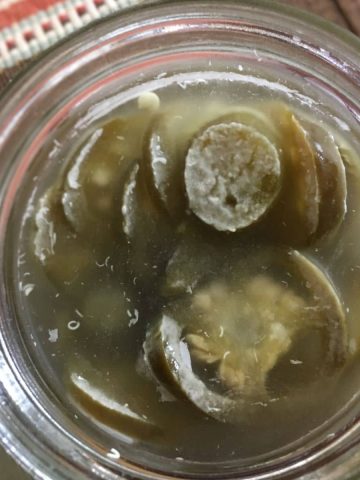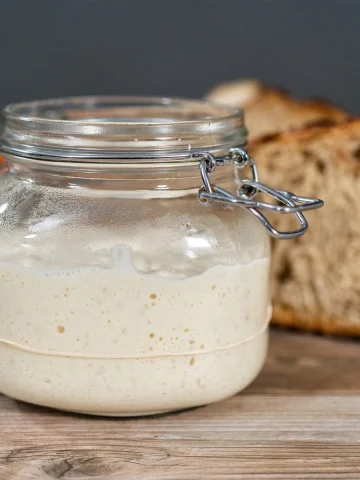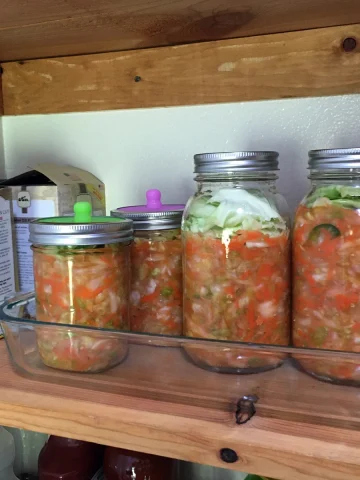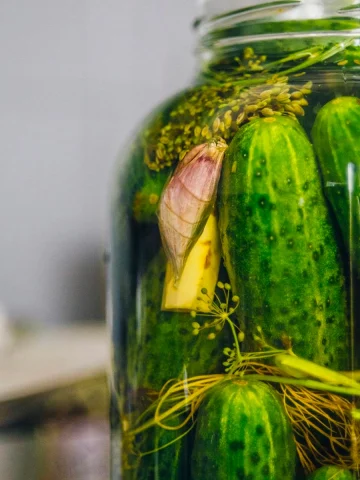Why did the top of my sauerkraut turn brown?
Occasionally, you might find that the top layer of a batch of sauerkraut turned brown. This can be due to a few issues: 1) the cabbage has been exposed to air, 2) the brine levels have dropped, 3) poorly cleaned jars 4) natural discoloration of some ingredients.
Discard the sauerkraut, and start fresh with a new batch. Or is it still safe to eat? Let's dig in!
Jump to:
I, too, have ended up with a few batches of discolored kraut and wondered if it was still edible. So, I decided to do some research, and here's what I figured out:
If a layer of sauerkraut turns brown at the top of a jar, that portion of sauerkraut has been exposed to air, oxidized, and caused to turn brown.
Since it protects the sauerkraut below, leave it alone, move your jar to the refrigerator, and remove and toss the oxidized layer when ready to eat it.
If sauerkraut brine is brown and discolored, this could be caused by some of the ingredients you added to the recipe.
Apples, pears, and fennel are a few ingredients that discolor during fermentation. In that case, eating is safe as long as the smell and taste are good.
However, if the sauerkraut has darkened a little bit after placing it in the refrigerator, that is normal and perfectly fine to eat.
But there's much more to know about sauerkraut turning brown, so let's keep going!
This article examines why sauerkraut turns brown, whether it can be saved, and how to prevent future batches from turning brown.
But ultimately, we're answering the question of why did my sauerkraut turn brown?
Let's jump in.
Why did my sauerkraut turn brown?
Sauerkraut is probably the most famous fermented food in the world and the easiest to make.
Chop up some cabbage, combine it with sea salt, stuff it in a jar, wait a few days, and voilà, you have sauerkraut. However, we know that even simple things can go wrong sometimes.
So for the busy people who like to make homemade sauerkraut, and have run into this problem, here are a few reasons why your sauerkraut has turned brown.
- The cabbage has been exposed to air and oxidized.
- The brine level has gone down and left the cabbage exposed to air.
- Ingredients like apples, pears, and fennel might have changed the color of the brine.
- The lid is not tight enough to keep air out.
- You did not use a weight to hold the vegetables below the brine.
- Cross-contamination between ferments.
Why does sauerkraut brine turn brown?
In this photo from a Reddit forum, you can see the brine has turned brown. In this scenario, it is likely the brine has turned brown due to the oxidation of the apple and fennel in the recipe. Since the cabbage below the brine looks a healthy green color, let it continue to ferment and then give it a taste test.
As with any fermentation recipe, if it smells or tastes off, then throw it out.
How to keep sauerkraut from turning brown?
So first things, first, create an anaerobic environment. After packing the cabbage and other ingredients in the jar, use weight and enough brine to create an anaerobic environment. This is the most important factor in fermenting any vegetables.
If you don't have fermentation weights, read my article, Fermentation Weights: How to Weigh Down Fermented Vegetables, for some easy DIY ideas.
Otherwise, The Pickle Helix coils, the MasonTops silicone pipe lids and weights set, and the Easy Fermenter Starter Kit are all great products to invest in if you plan to ferment more in the future.
Leave a little headspace of 1 -2 inches, allowing the brine and gasses to expand.
Monitoring your kraut is a very low-maintenance activity; a daily glance and after the first week, and you can taste it. If the brine levels have dropped below the cabbage, then quickly push the cabbage down again and close the jar.
Last update on 2025-05-20 / Affiliate links / Images from Amazon Product Advertising API
Avoid Contamination
Clean your fermentation vessel thoroughly to avoid any cross-contamination between ferments. Discoloration could arise from contamination from a previous ferment batch in your vessel.
Keeping containers for yeast fermentation separate from vegetable fermentation is a good idea. Or, at the very least, disinfect the containers thoroughly with hydrogen peroxide.
If you use a plastic container, the yeast can hide in the tiny scratches or cracks in the vessel and later affect the subsequent batch.
Signs your sauerkraut has gone bad?
How to spot a bad Ferment
If the cabbage has grown a slimy film on it, or mold that is green, pink, white, or black, or starts smelling yeasty or bad in general, toss it out and try again.
The change means the ferment was exposed to too much oxygen or contaminated during preparation, or the temperature was too warm.
The ferment smells intense and unpleasant. Your Nose Knows! So, if it smells off, don't eat it.
Beware that the vegetables can look good and have a terrible smell simultaneously. If the smell makes you want to gag, then toss it out.
That goes for taste, too; if you taste it and the flavor is off, don’t eat it. It might not smell bad, but the taste is off. Toss it out!
The ferment has turned slimy and discolored. Most vegetables will turn from a bright color to a duller or paler color during fermentation, but if it is slimy, toss it out!
More Troubleshooting Sauerkraut
- How to fix salty sauerkraut
- How to fix sauerkraut that is too sour
- Can you freeze sauerkraut for later?
Final Thoughts
Did I cover everything you wanted about sauerkraut discoloring or turning brown?
In this article, we looked at why sauerkraut turns brown, it is safe to eat, and ways to prevent it from happening in future batches.
But primarily focused on answering the question, why did my sauerkraut turn brown?
Also, don't throw away the sauerkraut brine! Drink it as a gut shot. The juice is full of all the beneficial properties of the sauerkraut. If the brine tastes too salty, dilute it with water.
Or use it as a salad dressing or pour it over your next batch of kraut to kickstart the fermentation process.






